
Reginald Denny (1891-1967)
The "Dennyplane"A Shop on Hollywood Boulevard
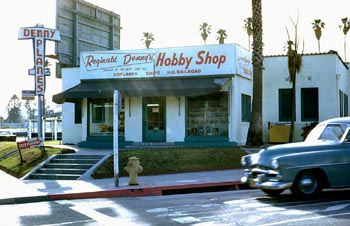 Reginald Denny's Hobby Shop, Hollywood Boulevard, 1961 Photo : Pete Soule - Click Image to Enlarge
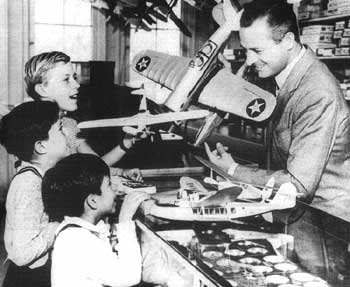 Reginald Denny at his Hobby Shop, Hollywood Boulevard Photo : Righter Family Archives - Click Image to Enlarge
Sadly, all traces have now disappeared A recent eMail from Kent Fletcher relates the following information...
"Thought I would offer a little more info on the shop. I grew up in Hollywood at 1954 Taft Avenue. If you can use a mapblast or similar utility, you'll see that Taft is the next street east of Van Ness (as in your "NOW" picture), and 1954 is two blocks north. Needless to say, I spent quite a number of hours in R.D.'s shop. My uncle had also hung out there when he was a kid in the 40's. Reg Denny Jr. comments...Reginald Denny Industries began business in 1935, was a corporation, controlling interest of which was owned by The Whittier Company. In 1939 "The Industries" became insolvent so dad and Paul Whittier were ousted, the Whittier Co. taking control and leasing the business including the corporate name "Reginald Denny Industries" to Pete Veer (spelling)? Later, I don't recall the timing, Pete Veer purchased "The Industries" including the name. Pete and his son operated the business for many years, than at some time apparently sold it. When Kent's uncle frequented the shop, it was most probably owned by the Whittier company being leased to, and operated by Pete Veer. During Kent's time "The Industries" was probably both owned and operated by Pete Veer and his son. I have no idea when the shop was sold by the Veer's, but 1963 could have been the year. I however, question this. Dad died as a result of a long series of illnesses, while visiting relatives in England in 1967. During a period when he was in the hospital, I recall him phoning "The Industries" talking I think, with Pete Veer's son to purchase a model as a gift for a healthcare worker at the hospital. This must have been no earlier than 1965 or 66. Apparently Pete Veer's son still owned the industries then, or at least still was employed there.
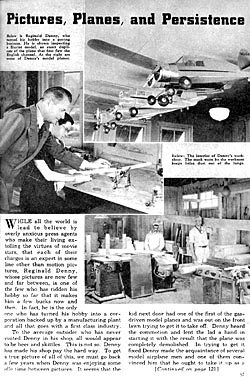 Pictures, Planes and Persistence This Mechanix Illustrated article continues here Jim Dunkin - Click Image to Enlarge
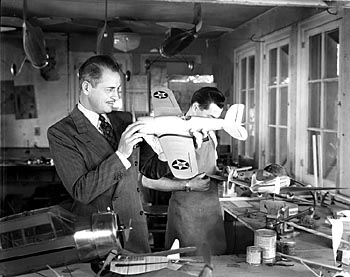 Reginald Denny in his workroom Photo : Jim Dunkin - Click Image to Enlarge Download a 1500pixel image
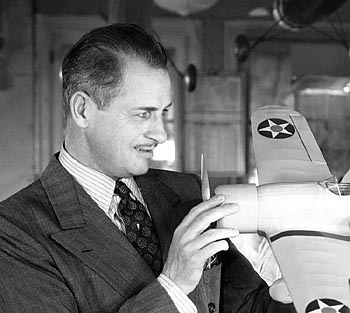 Reginald Denny in his workroom Photo : Jim Dunkin - Click Image to Enlarge Download a 1500pixel image
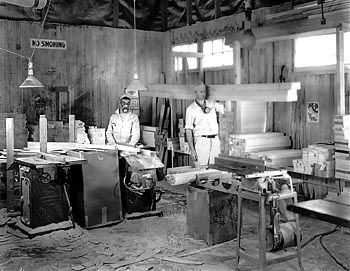 Denny's balsawood workshop Photo : Jim Dunkin - Click Image to Enlarge Download a 1500pixel image
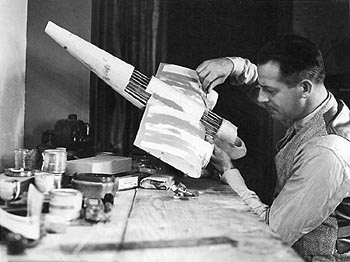 A craftsman at work Photo : Denny Family Archives - Click Image to Enlarge
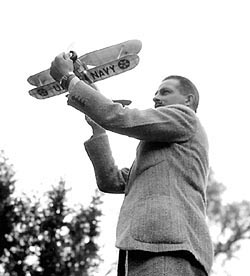 Test Flight Photo : Denny Family Archives - Click Image to Enlarge
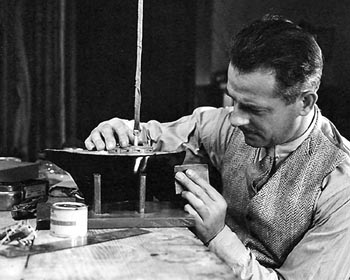 ...but not always an airplane modeller Photo : Denny Family Archives - Click Image to Enlarge
The Dennyplanealso seen as the 'Denny Plane'
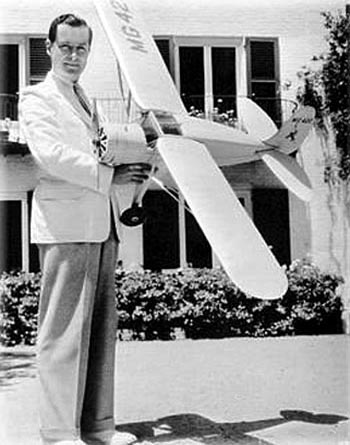 Robert Mongomery and his 'personalised' "Dennyplane" Photo : Denny Family Archives
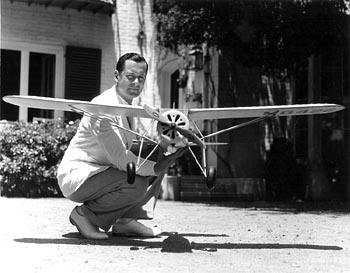 Robert Mongomery and his 'personalised' "Dennyplane" Photo : Denny Family Archives - Click Image to Enlarge Download a 1500pixel [340Kb] or 2500pixel [730Kb] image
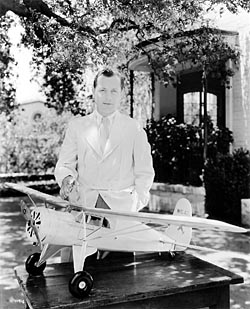 Robert Mongomery and his 'personalised' "Dennyplane" Photo : Denny Family Archives - Click Image to Enlarge Download a 1500pixel [560Kb] or 2000pixel [770Kb] image
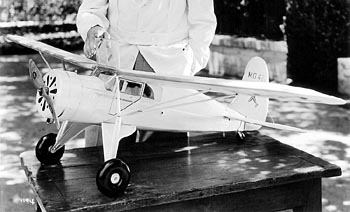 Robert Mongomery's 'personalised' "Dennyplane" Photo : Denny Family Archives - Click Image to Enlarge Download a 1500pixel [265Kb] image
That plane was perfect in every detail. A great example of the art of model building to perfection. It may have even had an interior. I occasionally ponder what happened to it. I wonder if it still exists in some hidden corner of this world? [R.D. Jr, April 18, 2003]
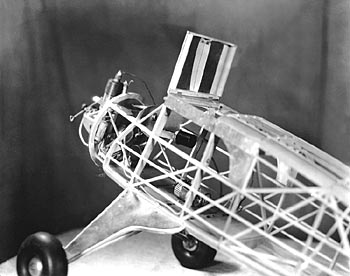 "Dennyplane", 1937 Photo : Jim Dunkin - Click Image to Enlarge Download a 1500 pixel [315Kb] image
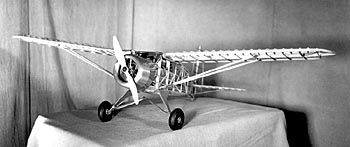 "Dennyplane", 1937 Photo : Jim Dunkin - Click Image to Enlarge Download a 1500 pixel [185Kb] image
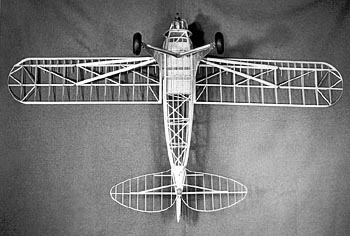 "Dennyplane", 1937 Photo : Jim Dunkin - Click Image to Enlarge Download a 1500 pixel [315Kb] image
The sale of model aircraft to 'kids' (say males 10 to 20 years) was based primarily on true models of existing airplanes. Comet, a manufacturer in Chicago, had over 200 people in assembling the kit parts and stuffing them in boxes in the late 30's. Most of these were quite small, spans less than 24" and low cost. The standard fare for model magazines - led by the publisher of sensational magazines Bernarr McFadden - nearly always had a plan featured that was bases on some existing aircraft. They were all rubber-powered. The minute there were contests (excepting 'scale') no one building a model of an existing aircraft had a remote chance of winning. The aerodynamics at low speeds are in many ways profoundly different from those of man carrying machines and the stability requirements are totally different (principally strong stability on all axes for free flight and for full size aircraft neutral on lateral, weak directional and moderate longitudinal stability). The performance based model, exemplified by the famous "Wakefield Cup" (from Lord Wakefield of the UK) and the string of world championships in the 30's developed a special kind of model. But these were all rubber powered, difficult to get a "real airplane" performance look with a burst of rubber power. The Dennyplane is a not a performance based aircraft -- it looks like a real plane -- but big enough to be a good flier and take advantage of the internal combustion engine introduced in 1929 but popularized by the American Bill Brown (from Philadelphia) in 1934 with mass production and marketing. ($21.50!!! BIG bucks) -- gas engine won the nationals in 1933 -- this changed everything for the people -- at least the well-to-do in the depression 30's -- that wanted a big model that looked like something. Flights as long as you wanted - just add more gas, so chasing became the time limit. There was a burst of these aircraft as soon as the Brown Jr. came on the market. For contests gas engines were put in a different class in 1934 and the engine run was limited to various times - less than a minute... 20 seconds just before WWII -- for international contests it is now 5 seconds. But these aircraft look like no full scale airplane. The rubber powered Denny models were a compromise -- they sort-of looked like a real plane but the model itself was designed to fly well at the expense of not looking "exactly" like some famous aircraft.
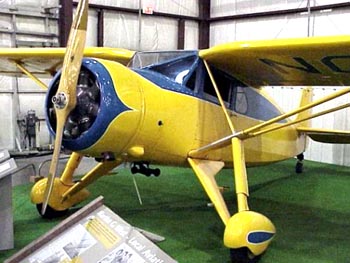 FairChild 24 G : An insiration for the "Dennyplane"? http://www.eaa231.org/Museum/Fairchild24/Fairchild24.htm
Reg Denny Jr. notes: The "Dennyplane" was definitely inspired by a full sized aircraft. The design was based upon planes owned by a friend of Dad's, Cecil Smallwood who had a flying service operated from Clover field, now Santa Monica Airport. This I believe was a 1935 to 1937 Fairchild.
Flying the "Dennyplane", 1938 The following is sequence of images most probably taken from a 16mm film of the event by Reginald Denny. Location probably 'Mines Field', Los Angeles. Can anyone confirm this location by the buildings shown in the 2nd and better still the 3rd image?
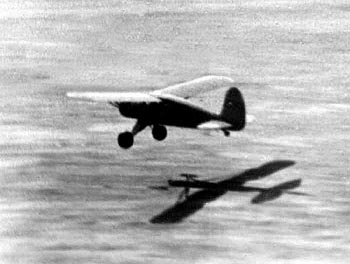 Take-Off
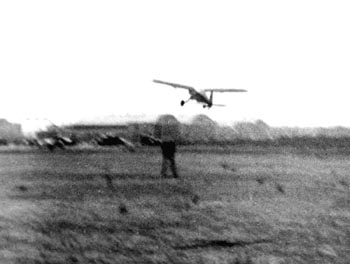 Ascent
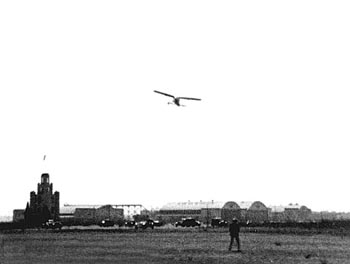 Turn and Return
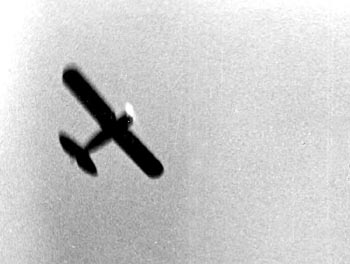 Overhead
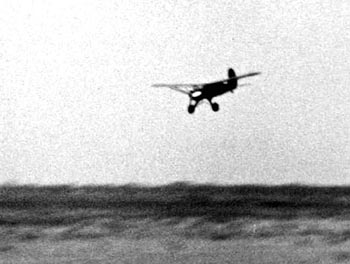 Landing approach
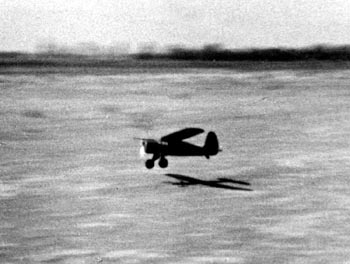 Touchdown
The "Dennyplane" By Dee B. Matthews with text and photos by Larry Kruse
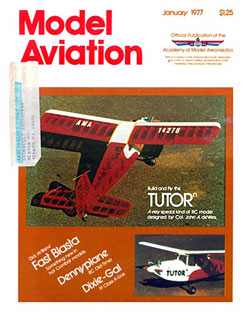 The "Dennyplane" Model Aviation, Jan 1977
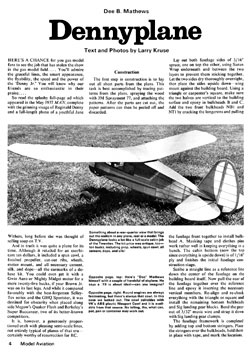 The "Dennyplane" p1 Model Aviation, Jan 1977
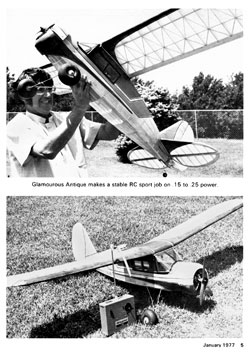 The "Dennyplane" p2 Model Aviation, Jan 1977
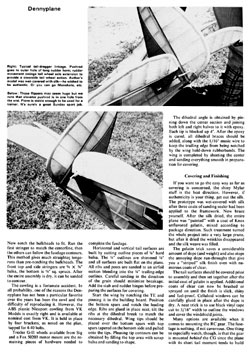 The "Dennyplane" p5 Model Aviation, Jan 1977
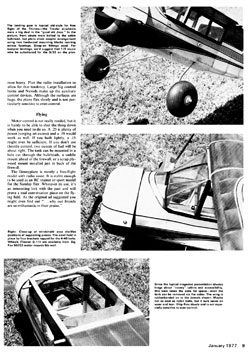 The "Dennyplane" p6 Model Aviation, Jan 1977
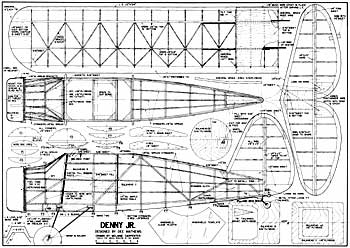 The "Dennyplane" pp3 & 4 Model Aviation, Jan 1977
Download as 2 x A4 pages p1 [2.2Mb] and p2 [2.4Mb]
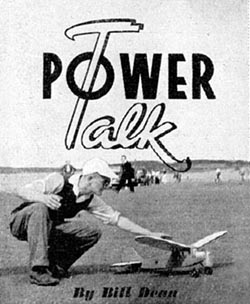 Power Talk, by Bill Dean, Feb., 1952
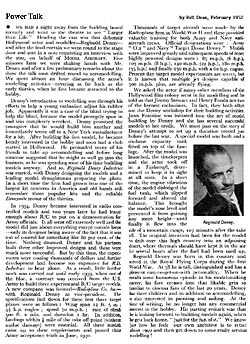 Power Talk, by Bill Dean, Feb., 1952
 Four Decades of Radio Controlling Aircraft, A Summary VMAA Newsletter, April, 1978
Dr. Naughton, Thanks very much for you kind reply to my e-mail. Here is some rather "sketchy" information, some of which you may find interesting. I am now seventy years old, and was a young child when Reginald Denny Industries was formed in 1935. To my knowledge, the Industries produced one free flight gasolene powered model aircraft. This I believe was designed using the Fairchild 24 model G as a design guide. I am however, not certain of this. This plane was powered by the "Dennymite" engine built by Walter Righter, Burbank, California. Your web site shows a "Denny Jr." I recall the exact plane shown in your photo, but thought this was a less detailed light version of the "Dennyplane", using non pigmented dope. The white colored "Dennyplane" shown in the 1937 advertizement in your site, was built I believe, as a gift to actor Robert Montgomery. To my knowledge this plane was never flown by Robert Montgomery, but was displayed in his home. The Industries also manufactured and sold a kit for a rubber band "wind up" plane called the Denny "Bullet". This as the name implies, was a fast low wing plane which really didn't have much endurance, but was fast, while airborne. Reginald Denny Jr. On Mon, Feb., 11, 2002, Reginald Denny Jr. wrote to this site with regard to the page on his father. "This is a complete bit of nostalgic trivia which has been researched, compiled and published pertaining to my father and Radioplane Co. It's more complete in some respects than what I have. Thanks very much, to whomever has taken time to research and publish this."
|
© Copyright 1999-2005 CTIE - All Rights Reserved - Caution |